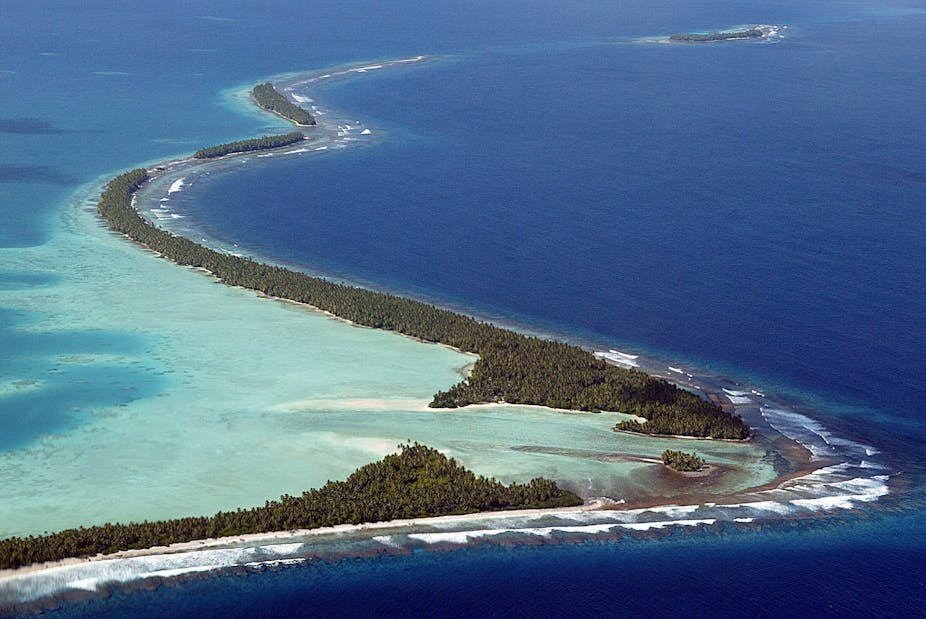The Pacific Islands are powerful icons in the politics of climate change.
Headlines such as “Sinking islands, vanishing worlds”, “Climate refugees in a drowning Pacific”, “Rising seas … washed an inhabited island off the face of the earth,” and “Tuvalu Toodle – oo” exemplify the way islands are framed in climate change discourses.
These discourses have given rise to the widely-held opinion that it’s inevitable that the islands of the South Pacific will be subsumed by rising seas, and in turn that people living on islands will have no choice but to flee.
The idea of resettling islanders as environmental refugees is prevalent in the Australian policy community.
The former head of the Australian Bureau of Agricultural and Resource Economics has explained the “appeal” of relocating small island states due to the financial ‘costs and benefits’, as compared to the costs of reducing greenhouse gas emissions.
Ross Garnaut said in 2009 that “The South Pacific countries will end up having their populations relocated to Australia or New Zealand, the rest of the world expects that and in the end, we’re likely to accommodate that, so there’s a solution there.”
Scholars, too, have suggested the large scale resettlement of people from islands to reduce their vulnerability to climate change.
One writes that “the 12,000 Tuvaluans still on Tuvalu, for example, could easily disperse among the millions of Sydney, Tokyo, Los Angeles or other large cities.”
In contrast to this God-like view, those who have actually collected data from Tuvalu argue that such discourses silence the needs and desires of Tuvaluans, and deny the possibilities for mitigation and adaptation strategies to sustain the rights of Tuvaluans to live in their homeland.
These ideas about forced migration and the need for resettlement are not well founded in knowledge about climate change, the Pacific Islands, and the people that live there.
For a start, even assuming people in the region do want to move as environmental conditions deteriorate, they may not be able to.
The Pacific is not Africa or South Asia, where crossing borders, though difficult, is logistically feasible. It is very difficult to move internationally from an island: it requires travel on a boat or a plane, which is expensive.
It also requires gaining entry through a major port, which requires a passport, a visa, money, and a high degree of literacy. For these reasons the majority of people in the South Pacific cannot move.
So, the real problem is not the trickle of individuals who might choose to and are able to leave, it’s the majority who cannot, and who will have to contend with deteriorating living conditions.
There is also much that can be done to avoid the impacts of climate change, ranging from increasing hydroponic food production, rainwater harvesting and desalinisation, improving building standards, improving management of vector-borne diseases, better health care systems, better disaster management institutions, and improved coastal zone and reef management policies.
Indeed many of these strategies have been devised and are already being implemented. People in the Pacific Islands are not without agency, adaptation is possible, and migration is by no means inevitable.
And there is time for these adaptations to take effect. This graph of expected rises in sea-level shows an upper estimate of an 82 cm rise by the end of the century.
Sea-level rise is perhaps the most critical driver of environmental changes in the Pacific. So, if we take the worst-case scenario, in 100 years things will be tough on the coasts of the Pacific.
But even assuming high rates of ocean acidification and coral bleaching, people will, in all likelihood, still be living on the islands for the next 50 years at least.
Life might not be so good, but it might not be that much worse either – islands will still be there, and adaptation actions can do much to sustain a decent life on the islands despite climate change.
Of course, much depends on the extent to which emissions are reduced, and how much adaptation occurs. Because of lags in the climate system, cuts in emissions have to begin now.
But we do have time to work on adaptation, and the adaptation task gets easier the more we can reduce emissions.
If the right of people living on islands to have a homeland is to be protected, this is crucial.
There is nothing inevitable about climate change ushering in the end of the ability of people to live on these islands in the coming decades.
It’s worrying that when people think about the problem of climate change in the Pacific Islands, they immediately think about forced migration or resettlement. These outcomes are not inevitable. They can be delayed and maybe even avoided through emissions reductions and adaptation strategies.

